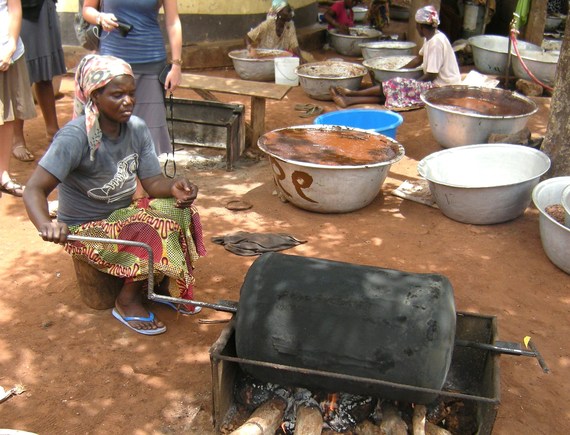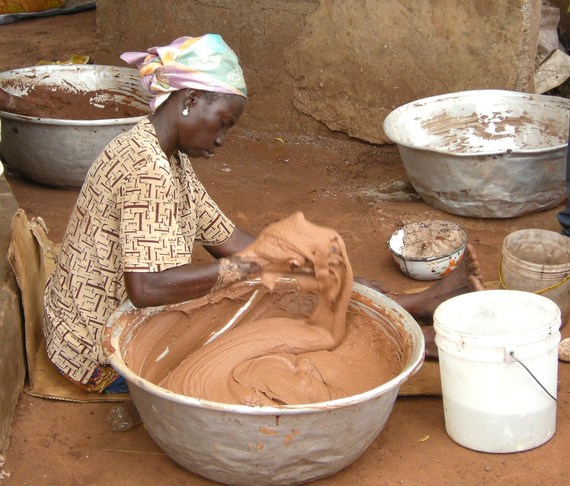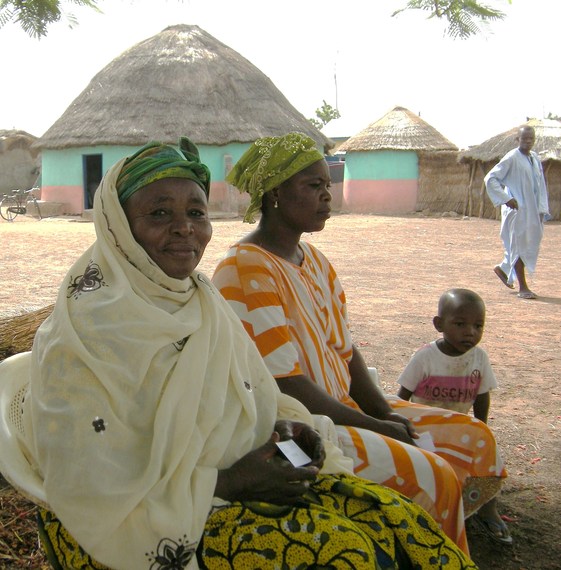Traffic jams in the capital. Construction projects at every turn. Cell phones in constant use. Just a few signs that Ghana's economy is one of the hottest in the world, growing 15 percent in 2011 and 7.9 percent in 2012, according to World Bank figures.
But, as in many countries that leap from "least developed" to "middle-income," not everyone enjoys the benefits. Ghana has cut the national poverty rate in half, meeting the first of the United Nations' eight Millennium Development Goals ahead of the 2015 schedule. Meanwhile, two of its three northern regions have slipped deeper into poverty. The north, with a quarter of the population, accounts for more than half the poor.
The proportion of Ghana's 25 million people who live below the poverty line dropped from 36.5 percent in 1991-92 to 18.2 percent in 2005-06, according to the 2010 Ghana Millennium Development Goals Report (p. 84).
Over the same period, the Northern Region rate declined (54.2 percent to 38.7 percent) but rates rose in both Upper East (53.4 percent to 60.1 percent) and Upper West (74.3 percent to 79 percent). The 2010 report by Ghana's government and the United Nations Development Program provides the latest data available.
The reasons for the disparity are many: The north is arid much of the year, sparsely settled, poorly linked to the south and, until recently, wracked by local conflicts over chieftaincies and land. Although the region is landlocked, Ghanaians refer to it as "overseas" to convey how disconnected it is. Meanwhile, the southern areas are covered in rainforests and farmlands that produce cocoa, vegetables and tropical fruits as well as timber and gold. The north also is heavily Muslim and differs ethnically from the overwhelmingly Christian south.
Ghanaian leaders run one of Africa's strongest democracies and want to be seen as working for all. They call their current poverty reduction plan "Ghana Shared Growth and Development Agenda." President John Dramani Mahama, in office since July 2012, comes from the Northern Region.
Those factors helped drive the government response to regional disparity -- the launch of the Savannah Accelerated Development Initiative in 2009 and the Savannah Accelerated Development Authority in 2010. The authority, known as SADA, is meant "to promote sustainable development using the notion of a forested and green north to catalyze climate change reversal and improve livelihoods of the most vulnerable citizens," according to the National Development Planning Commission.
SADA headquarters in Tamale, in Northern Region, opened in 2012. During my visit there in June, SADA leaders said they coordinate existing development work but that it was too soon to measure impacts. Their goals are big: to cut poverty to 20 percent, double incomes in 20 years and encourage private investment in the region.
Yakubu Zakaria of the Integrated Social Development Center said by email that SADA has great potential but has started out with "the usual elitist approach to a local problem." The work needs more involvement from local people and organizations, he said. ISODEC is a Ghanaian research and advocacy group.
In Ghana's capital, Accra, World Bank officials said the cocoa industry has been crucial to uplifting the rural poor in southern Ghana. The government runs a marketing board, and research efforts for cocoa, which employs about 800,000 farmers and many more farmhands, and is one of Ghana's top foreign exchange earners. Ghana is the world's second largest cocoa producer, with 22 percent of the world crop, according to the World Cocoa Foundation.
Michael Amoah, the Cocoa Board's deputy research manager, said the board is researching a northern Ghana crop -- shea nuts -- that could spur the region's growth. Shea nut production rose 38 percent between 2007 and 2011, according to government figures. (p. 69)
The shea tree has not been domesticated. Gathering the nuts in the wild and roasting, crushing and boiling them to extract shea butter is a laborious process long considered women's work. As shea butter, used in foods and cosmetics, becomes more profitable, the hope is that it will continue to benefit women, who are a disproportionate number of the poor.
Rice also is an important food and commercial crop in northern Ghana. The government and the U.S. Agency for International Development support an irrigation project for 500 farmers that taps the waters of the Volta River system.
In the village of Naha, outside Tamale, the farmers' organization welcomed a group of visitors from New York University. The members spoke proudly of their efforts to lift their community from poverty, noting that their organization includes 25 men and 26 women farmers, and that its name, Kulnoli din Vella, means, "If you are more welcoming, you will get more visitors."
 The shea tree has not been domesticated, in part because it takes a decade or more for the tree to mature sufficiently to bear fruit. Women gather the fruit from wild shea trees across the northern regions of Ghana. The fruit is edible and the kernels, known as shea nuts, are rich in oils that can be turned into shea butter. Roasting is one of several steps needed to extract shea butter from the nuts, which are about the size and shape of hazelnuts. All photos by Barbara Borst
The shea tree has not been domesticated, in part because it takes a decade or more for the tree to mature sufficiently to bear fruit. Women gather the fruit from wild shea trees across the northern regions of Ghana. The fruit is edible and the kernels, known as shea nuts, are rich in oils that can be turned into shea butter. Roasting is one of several steps needed to extract shea butter from the nuts, which are about the size and shape of hazelnuts. All photos by Barbara Borst
 Shea nuts must be boiled as part of the process of extracting shea butter, which sells on the international market as well as the local market. Members of a women's cooperative in Tamale work in groups on the long process of extracting shea butter, an ingredient used in cosmetics and food production. Once the nuts have been roasted, crushed and boiled, women knead the mixture for hours as it cools in order to bring the butter to the surface.
Shea nuts must be boiled as part of the process of extracting shea butter, which sells on the international market as well as the local market. Members of a women's cooperative in Tamale work in groups on the long process of extracting shea butter, an ingredient used in cosmetics and food production. Once the nuts have been roasted, crushed and boiled, women knead the mixture for hours as it cools in order to bring the butter to the surface.
 Bontanga Irrigation Project works with about 500 farmers, in 10 farmer-based organizations, to produce rice in the arid north by tapping the waters of the Volta River system. The irrigation project, which is supported by Ghana's government, the U.S. Agency for International Development and others, includes a demonstration of two planting techniques to determine which is more productive. Yakubu Saaka Daniel, vice chair of one of the farmers' organizations, works closely with the irrigation project.
Bontanga Irrigation Project works with about 500 farmers, in 10 farmer-based organizations, to produce rice in the arid north by tapping the waters of the Volta River system. The irrigation project, which is supported by Ghana's government, the U.S. Agency for International Development and others, includes a demonstration of two planting techniques to determine which is more productive. Yakubu Saaka Daniel, vice chair of one of the farmers' organizations, works closely with the irrigation project.
 Women of Dalun village, outside Tamale, the main city in Ghana's Northern Region, talked about their efforts to see that their children, especially their daughters, learn to read and write; the women did not have that opportunity.
Women of Dalun village, outside Tamale, the main city in Ghana's Northern Region, talked about their efforts to see that their children, especially their daughters, learn to read and write; the women did not have that opportunity.
Our 2024 Coverage Needs You
It's Another Trump-Biden Showdown — And We Need Your Help
The Future Of Democracy Is At Stake
Our 2024 Coverage Needs You
Your Loyalty Means The World To Us
As Americans head to the polls in 2024, the very future of our country is at stake. At HuffPost, we believe that a free press is critical to creating well-informed voters. That's why our journalism is free for everyone, even though other newsrooms retreat behind expensive paywalls.
Our journalists will continue to cover the twists and turns during this historic presidential election. With your help, we'll bring you hard-hitting investigations, well-researched analysis and timely takes you can't find elsewhere. Reporting in this current political climate is a responsibility we do not take lightly, and we thank you for your support.
Contribute as little as $2 to keep our news free for all.
Can't afford to donate? Support HuffPost by creating a free account and log in while you read.
The 2024 election is heating up, and women's rights, health care, voting rights, and the very future of democracy are all at stake. Donald Trump will face Joe Biden in the most consequential vote of our time. And HuffPost will be there, covering every twist and turn. America's future hangs in the balance. Would you consider contributing to support our journalism and keep it free for all during this critical season?
HuffPost believes news should be accessible to everyone, regardless of their ability to pay for it. We rely on readers like you to help fund our work. Any contribution you can make — even as little as $2 — goes directly toward supporting the impactful journalism that we will continue to produce this year. Thank you for being part of our story.
Can't afford to donate? Support HuffPost by creating a free account and log in while you read.
It's official: Donald Trump will face Joe Biden this fall in the presidential election. As we face the most consequential presidential election of our time, HuffPost is committed to bringing you up-to-date, accurate news about the 2024 race. While other outlets have retreated behind paywalls, you can trust our news will stay free.
But we can't do it without your help. Reader funding is one of the key ways we support our newsroom. Would you consider making a donation to help fund our news during this critical time? Your contributions are vital to supporting a free press.
Contribute as little as $2 to keep our journalism free and accessible to all.
Can't afford to donate? Support HuffPost by creating a free account and log in while you read.
As Americans head to the polls in 2024, the very future of our country is at stake. At HuffPost, we believe that a free press is critical to creating well-informed voters. That's why our journalism is free for everyone, even though other newsrooms retreat behind expensive paywalls.
Our journalists will continue to cover the twists and turns during this historic presidential election. With your help, we'll bring you hard-hitting investigations, well-researched analysis and timely takes you can't find elsewhere. Reporting in this current political climate is a responsibility we do not take lightly, and we thank you for your support.
Contribute as little as $2 to keep our news free for all.
Can't afford to donate? Support HuffPost by creating a free account and log in while you read.
Dear HuffPost Reader
Thank you for your past contribution to HuffPost. We are sincerely grateful for readers like you who help us ensure that we can keep our journalism free for everyone.
The stakes are high this year, and our 2024 coverage could use continued support. Would you consider becoming a regular HuffPost contributor?
Dear HuffPost Reader
Thank you for your past contribution to HuffPost. We are sincerely grateful for readers like you who help us ensure that we can keep our journalism free for everyone.
The stakes are high this year, and our 2024 coverage could use continued support. If circumstances have changed since you last contributed, we hope you'll consider contributing to HuffPost once more.
Already contributed? Log in to hide these messages.



